I am looking to simulate circuits on Falstad: http://www.falstad.com/circuit/circuitjs.html . One of the features on the website is the ability to add an external voltage source programmable with JavaScript (Can be found under the drop down toolbar > Inputs and Sources > Add External Voltage Source (Javascript)). How can I do this? Is there some documentation available?
1 Answers
The falstad website has an "example" here, although it doesn't explain much outright: https://www.falstad.com/circuit/jsinterface.html
The circuit simulator runs in an <iframe>.
Elsewhere on the page, there are two input fields:
- extsin frequency:
<input id="freq" value="10">
- extsin amplitude:
<input id="ampl" value="10">
Note their id values of freq and ampl.
extsin is the name of the external voltage source within the simulation. The name can be changed by editing it:

Further down in the page source is the javascript block. Below is the whole code block for reference.
(Unfortunately I don't think StackExchange has a way to format line numbers in code blocks)
<script>
// get iframe the simulator is running in. Must have same origin as this file!
var iframe = document.getElementById("circuitFrame");
var sim;
var freq, ampl;
function round(x) {
return Math.round(x*1000)/1000;
}
// called when simulator updates its display
function didUpdate(sim) {
var info = document.getElementById("info");
info.innerHTML = "time = " + round(sim.getTime()) + "<br>running = " + sim.isRunning();
// get voltage of labeled node "vsense"
var vsense = sim.getNodeVoltage("vsense");
info.innerHTML += "<br>V(vsense) = " + round(vsense);
freq = parseFloat(document.getElementById("freq").value);
ampl = parseFloat(document.getElementById("ampl").value);
var bstr = "";
var bval = 0;
var i;
for (i = 7; i >= 0; i--) {
var v = sim.getNodeVoltage("D" + i);
if (v > 2.5) {
bstr += "1";
bval = 2*bval+1;
} else {
bstr += "0";
bval = 2*bval;
}
}
info.innerHTML += "<br>counter value = <tt>" + bstr + "</tt> = " + bval;
}
// called every timestep
function didStep(sim) {
var t = sim.getTime();
var q = ampl*Math.sin(freq*Math.PI*2*t);
// set voltage of external voltage "extsin"
sim.setExtVoltage("extsin", ampl*Math.sin(freq*Math.PI*2*t));
}
// callback called when simulation is done initializing
function simLoaded() {
// get simulator object
sim = iframe.contentWindow.CircuitJS1;
// set up callbacks on update and timestep
sim.onupdate = didUpdate;
sim.ontimestep = didStep;
}
// set up callback
iframe.contentWindow.oncircuitjsloaded = simLoaded;
</script>
Here are the key parts for setting the external voltage:
The values from the frequency and amplitude inputs on the page are read here and stored:
freq = parseFloat(document.getElementById("freq").value);
ampl = parseFloat(document.getElementById("ampl").value);
Further down, the voltage of external source of name extsin is set using those freq and ampl values:
// set voltage of external voltage "extsin"
sim.setExtVoltage("extsin", ampl*Math.sin(freq*Math.PI*2*t));
- 5,102
- 5
- 31
- 56
-
The real key is `sim.setExtVoltage(name, value)`, either on-change if it's not dependent on the sim time or in an `ontimestep` callback if it is. The rest is a lot of boilerplate for this specific setup. – hobbs Oct 13 '21 at 16:52